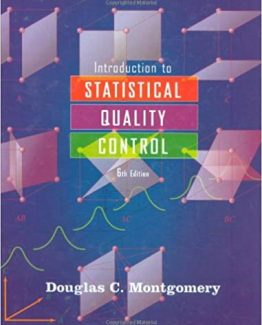Basics of Engineering Economy 3rd Edition by Leland Blank, ISBN-13: 978-1259875984
[PDF eBook eTextbook]
- Publisher: McGraw Hill; 3rd edition (January 27, 2020)
- Language: English
- ISBN-10: 1259875989
- ISBN-13: 978-1259875984
The Basics of Engineering Economy is designed to assist students in understanding and using the fundamental concepts and methods of economic evaluation to materially enhance rational data-centered decision-making in all these dimensions. This text covers the basic techniques and applications of engineering economy for all disciplines in the engineering profession.
The third edition concentrates on fundamental techniques and their applications, the efficient use of spreadsheets, and a rich coverage of personal financial situations in which engineering economy techniques can be applied easily and rapidly. The text presents the topics in condensed formats when compared to the larger text Engineering Economy.
Table of Contents:
Cover
Format for Spreadsheet Functions on Excel©
Half Title Page
Title Page
Copyright
Dedication
Brief Contents
Contents
Preface
Connect
Chapter 1: Foundations of Engineering Economy 1
Purpose and Learning Outcomes 1
1.1 What Is Engineering Economy? 2
1.2 Performing an Engineering Economy Study 2
1.3 Rates and the Time Value of Money 4
1.4 Equivalence 10
1.5 Simple and Compound Interest 11
1.6 Inflation and Purchasing Power of Money: An Introduction 16
1.7 Terminology and Symbols 20
1.8 Cash Flows: Their Estimation and Diagramming 22
1.9 Introduction to Spreadsheet and Calculator Functions 27
1.10 Ethics and Economic Decisions 30
Summary 35
Problems 35
Additional Problems and FE Exam Review Questions 41
Chapter 2: Factors: How Time and Interest Affect Money 43
Purpose and Learning Outcomes 43
2.1 Single-Payment Formulas (F/P and P/F) 44
2.2 Uniform-Series Formulas (P/A, A/P, A/F, F/A) 50
2.3 Gradient Formulas 54
2.4 Calculations for Cash Flows That Are Shifted 57
2.5 More Examples Using Spreadsheets and Calculators 62
Summary 67
Problems 68
Additional Problems and FE Exam Review Questions 77
Chapter 3: Nominal and Effective Interest Rates 79
Purpose and Learning Outcomes 79
3.1 Nominal and Effective Interest Rate Statements 80
3.2 Effective Interest Rate Formulation 82
3.3 Reconciling Compounding Periods and Payment Periods 85
3.4 Equivalence Calculations Involving Only Single-Amount Factors 86
3.5 Equivalence Calculations Involving Series with PP ≥ CP 87
3.6 Equivalence Calculations Involving Series with PP < CP 90
3.7 Using Spreadsheets for Effective Interest Rate Computations 92
3.8 Understanding Personal Finance Debt and Investments 94
Summary 101
Problems 101
Additional Problems and FE Exam Review Questions 106
Chapter 4: Present Worth Analysis 108
Purpose and Learning Outcomes 108
4.1 Formulating Alternatives 109
4.2 Present Worth Analysis of Equal-Life Alternatives 111
4.3 Present Worth Analysis of Different-Life Alternatives 114
4.4 Capitalized Cost Analysis 118
4.5 Evaluation of Independent Projects: An Introduction 123
4.6 Additional Examples Using Spreadsheets for PW Analysis 125
Summary 127
Problems 128
Additional Problems and FE Exam Review Questions 135
Chapter 5: Annual Worth Analysis 137
Purpose and Learning Outcomes 137
5.1 AW Value and Capital Recovery Calculations 138
5.2 Evaluating Alternatives Based on Annual Worth 140
5.3 AW of a Long-Life or Infinite-Life Investment 143
5.4 Additional Spreadsheet Examples for AW Analysis 146
Summary 148
Problems 148
Additional Problems and FE Exam Review Questions 153
Chapter 6: Rate of Return Analysis 154
Purpose and Learning Outcomes 154
6.1 Interpretation of ROR Values 155
6.2 ROR Calculation 156
6.3 Cautions When Using the ROR Method 161
6.4 Understanding Incremental ROR Analysis 162
6.5 ROR Evaluation of Two or More Mutually Exclusive Alternatives 166
6.6 Multiple ROR Values 170
6.7 Techniques to Remove Multiple ROR Values 174
6.8 More Spreadsheet and Calculator Examples to Determine ROR Values 180
Summary 184
Problems 185
Additional Problems and FE Exam Review Questions 193
Chapter 7: Benefit/Cost Analysis and Public Sector Projects 196
Purpose and Learning Outcomes 196
7.1 Public Sector Projects: Description and Ethics 197
7.2 Benefit/Cost Analysis of a Single Project 202
7.3 Profitability Index for Project Evaluation 205
7.4 Incremental B/C Evaluation of Two or More Alternatives 207
7.5 Using Spreadsheets for B/C Analysis 213
Summary 215
Problems 215
Additional Problems and FE Exam Review Questions 220
Chapter 8: Breakeven, Payback, Sensitivity, and Risk Analysis 222
Purpose and Learning Outcomes 222
8.1 Breakeven Analysis for a Single Project 223
8.2 Breakeven Analysis between Two Alternatives 230
8.3 Payback Period Analysis 233
8.4 Sensitivity Analysis for Variation in Estimates 237
8.5 Sensitivity Analysis of Multiple Parameters for Multiple Alternatives 241
8.6 Using Spreadsheets for Sensitivity or Breakeven Analysis 243
8.7 Fundamentals of Risk in Economic Evaluations 248
8.8 Alternative Evaluation with Risk Considered 257
Summary 263
Problems 264
Additional Problems and FE Exam Review Questions 273
Chapter 9: Replacement and Retention Decisions 276
Purpose and Learning Outcomes 276
9.1 Basics of a Replacement Study 277
9.2 Economic Service Life 279
9.3 Performing a Replacement Study 281
9.4 Defender Replacement Value 289
9.5 Using Spreadsheets for ESL and Replacement Studies 290
Summary 293
Problems 294
Additional Problems and FE Exam Review Questions 299
Chapter 10: Effects of Inflation 302
Purpose and Learning Outcomes 302
10.1 Understanding the Impact of Inflation (and Deflation) 303
10.2 PW Calculations Adjusted for Inflation 306
10.3 FW Calculations Adjusted for Inflation 312
10.4 AW Calculations adjusted for Inflation 318
10.5 Another Spreadsheet Example to Adjust for Inflation 319
Summary 321
Problems 321
Additional Problems and FE Exam Review Questions 325
Chapter 11: Cost Estimation and Allocation 327
Purpose and Learning Outcomes 327
11.1 How Cost Estimates are Made 328
11.2 Unit Method 334
11.3 Cost Indexes 335
11.4 Cost-Estimating Relationships: Cost-Capacity Equations 338
11.5 Cost-Estimating Relationships: Factor Method 340
11.6 Cost-Estimating Relationships: Learning Curve 342
11.7 Indirect Cost Estimation and Allocation 345
Summary 351
Problems 352
Additional Problems and FE Exam Review Questions 356
Chapter 12: Depreciation Methods 358
Purpose and Learning Outcomes 358
12.1 Depreciation Terminology 359
12.2 Straight Line (SL) Depreciation 362
12.3 Declining Balance Depreciation 363
12.4 Modified Accelerated Cost Recovery System (MACRS) 366
12.5 Two More Depreciation Methods 369
12.6 Switching Between Classical Methods; Relation to MACRS Rates 371
12.7 Using Spreadsheets for Depreciation Computations 373
12.8 Depletion Methods 376
Summary 378
Problems 379
Additional Problems and FE Exam Review Questions 383
Chapter 13: After-Tax Economic Analysis 384
Purpose and Learning Outcomes 384
13.1 Fundamentals of Income Taxes: Corporate and Individual 385
13.2 Before-Tax and After-Tax Alternative Evaluation 390
13.3 How Depreciation Can Affect an After-Tax Study 393
13.4 After-Tax Replacement Study 401
13.5 Capital, the Cost of Capital, and Taxes 403
13.6 Using a Spreadsheet for Expanded After-Tax Evaluation 408
13.7 After-Tax Value-Added Analysis 412
Summary 414
Problems 414
Additional Problems and FE Exam Review Questions 422
Chapter 14: Alternative Evaluation Including Noneconomic Attributes 424
Purpose and Learning Outcomes 424
14.1 Overview and Key Attributes 425
14.2 Importance Score and Weight for Each Attribute 426
14.3 Value Rating for Each Alternative 428
14.4 Alternative Evaluation and Selection 429
Summary 431
Problems 431
Additional Problems and FE Exam Review Questions 433
Appendix A: Using Spreadsheets and Microsoft Excel© 435
A.1 Introduction to Using Excel© 435
A.2 Organization (Layout) of the Spreadsheet 438
A.3 Excel Functions Useful in Engineering Economy (alphabetical order) 439
A.4 Goal Seek—A Spreadsheet Tool for Breakeven and Sensitivity Analyses 448
A.5 Error Messages 449
Appendix B: Accounting Reports and Business Ratios 450
B.1 The Balance Sheet 450
B.2 Income Statement and Cost of Goods Sold Statement 451
B.3 Business Ratios 453
Appendix C: Glossary of Terms and Symbols 457
Reference Materials 459
Interest Factor Tables 461
Index 487
What makes us different?
• Instant Download
• Always Competitive Pricing
• 100% Privacy
• FREE Sample Available
• 24-7 LIVE Customer Support





